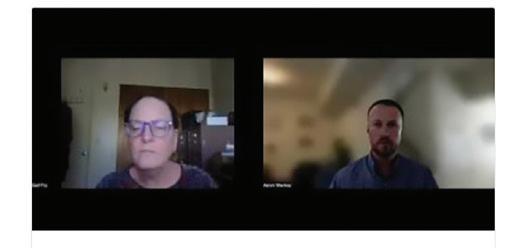
10 minute read
Teens Confront Epidemic of Dating Violence
By Peter White
The Centers for Disease Control & Prevention recently flagged an alarming increase in teen dating violence, with some surveys showing rates as high as 1 in 3 relationships.
Advertisement
progress,” she said.
Maya Henry said she will never feel safe on public transit. “I ride the bus every day. That is a place where I have been a target of sexual assaulted more than once.
“The thing about it is that it robs you of your innocence forever, and I don’t know if that’s something that you could ever really give back or take back, and I hope one day that’ll happen,” she said.
Young people are coming of age without knowing how to create a loving relationship or what the warning signs are that maybe they’re not in a good one.
So says Ana Campos, 17, who was blinded by “fake love” and thought everything was fine. Her sister recognized the red flags Ana was ignoring.
“He was very manipulative. He would constantly like, check my phone without my permission, and just be angry over the smallest things,” Campos recalled. She has been in therapy for two years. Campos is slowly leaving her toxic relationship behind.
She is one of a growing number of teenage activists dedicated to educating their peers about the dangers of teen dating violence and how to prevent it. The Centers for Disease Control & Prevention recently flagged an alarming increase in teen dating violence, up from the one out of 12 teens who reported having experienced it in 2021. Some youth surveys report the number of victims at one out of three.
Ana Campos shares the red flags she missed early on in a relationship that became abusive. She says schools should provide education on relationships, including recognizing ‘red flags’ and ‘green flags’, so that teens understand what constitute a safe and healthy relationship and can break the cycle of violence.
An EMS briefing marking February as Teen Dating Violence Prevention month featured four high school students who work with the California Partnership to End Domestic Violence.
“It’s valuable to have youth speaking out on these issues because they are able to give you an inside peak as to what relationships, both intimate and friends and peers, look like today,” said Megan Tanahashi, communications analyst for the Partnership.
Isha Raheja started working with the House of Ruth women’s shelter last year. She promoted the Awareness through Art Showcase against teen dating violence at her school but it was a hard sell to some of her classmates. Many of the fliers she posted around campus were torn down.
“It’s no surprise to me that teen dating violence can be regarded as taboo by some,” she said. Now a senior, Raheja leads a sex education reform club at her school and she recruited one reluctant classmate whose parents had opted her out of sex education.
When Raheja first talked to her about dating violence, her classmate was taken aback and said it might not be an appropriate subject. But she came back the next day and they kept talking. Soon the girl was regularly attending club meetings.
“Speaking on a personal level with individuals to turn apathy amongst students to empathy helped me build a group of likeminded individuals and further
She volunteers at Peace Over Violence, a youth violence prevention center headquartered in Los Angeles. She says her friends have a buddy system whenever anyone goes out so they can track each other’s whereabouts.
Healing requires unlearning certain behaviors, attitudes, and stigmas, Henry said.
“It starts with making the conscious effort to not judge yourself or others… but to actually sit down with someone who may have inflicted violence on someone else and try and find a place where instead of looking at them and thinking about the violence they caused, think about the potential they have to unfurl that violence and apologize and learn and make right their wrong.”
Restorative justice can’t make the trauma disappear but it can help both victim and perpetrator get beyond it. Henry noted that it’s hard to be joyful without feeling safe but there are places she feels very safe and comfortable.
Armaan Sharma is a sophomore at a small private school in Fremont, a Bay Area suburb with a 60% Asian population.
An open and respectful dialogue on dating and relationships between parents and teens is key to keeping kids safe in their relationships, says Armaan Sharma.
In his freshman year, Sharma took a class called Choices that briefly mentioned relationships. “Why don’t we teach about relationships more?
Confidential Informant is exposed by the San Bernardino County Sheriff Department after it argued it needed to indefinitely seal the search warrants to protect them

Everyone thinks that developing relationships it’s an natural skill that all humans have. If that were true, why do we see 1 in 3 teens in America experience some sort of dating violence, whether physical, sexual, emotional or psychological?”
Sharma noted that underregulated social media is posing a greater threat to youth with each passing day. Instagram is a platform where perpetrators of violence or predators have easy access to a whole lot of youth, he says.
“Netflix has movies like 365 days, which quite literally romanticize rape.”
Sharma says teen dating violence can affect everyone, including men, and, in fact, marginalized groups like the LGBTQ community, often experience much higher rates of such violence but they are underrepresented in the movement to end it. “It makes no sense because we can’t attempt to solve a problem that affects everyone if everyone isn’t involved,” he said.
The conversation should begin at home, says Kandee Lewis, CEO/President of Positive Results Center and Founder of Black Women Leaders of Los Angeles. The Board of Supervisors named Lewis Woman of The Year in 2017. She works with youth and parents on domestic violence, sexual assault, and suicide prevention.
“It’s important to talk to our children about what a healthy relationship is, what is acceptable behavior and what is unacceptable behavior,” says Lewis.
“We all want to be loved and we want to be accepted. And so, if we’re not getting the kind of attention that we need, we will go and seek that negative attention. It’s still attention and we’re gonna get it from wherever we can find it,” Lewis said.
“Your child really wants to know that you care, because if you don’t take the time to talk to your child, someone else will. And that other person could be the abuser.”.
Opinion -- Black, Unhoused and Mentally Challenged: The Case for Housing and Health Care
Dr. Lenore A. Tate | Special to California Black Media Partners fatal, health consequences. In addition, the daily struggles of coping with racism and sexism further exacerbate mental and emotional stress,” the write-up on the website reports. warrant, one of nine search warrants released, to the Electronic Frontier Foundation (EFF) during their legal dispute, EFF gave a copy of the search warrant to The San Bernardino American News.
When these intersecting issues go unaddressed, they can compound and adversely affect individuals.
On January 11, 2023, the California Supreme Court declined to hear the Electronic Frontier Foundation’s Petition for review on the issue of whether San Bernardino County could indefinitely seal search warrants, when a confidential informant was at its source.
In a legal dispute between the Electronic Frontier Foundation and the San Bernardino Superior Court, the San Bernardino County Sheriff’s Department and District Attorney’s Office that went to the California Supreme Court, the County alleged it had to secure the safety of confidential informants, now The San Bernardino American News has discovered an unsealed search warrant that reveals the identity of a confidential informant and a victim of domestic violence.
The San Bernardino County District Attorney (SBCDA) released the unsealed search
When they were arguing in front of the 4th District Court of Appeal (Appellate Court), the San Bernardino Superior Court (SBSC) through attorneys for the San Bernardino County Sheriff’s Department (SBCSD) and District Attorney (The County), the County defended its position that the search warrants needed to be sealed indefinitely to protect any confidential informants and official information. Official information is described as information, that was not open, or officially disclosed to the public, obtained in confidence
Opinion -- Black, Unhoused and Mentally Challenged: The Case for Housing and Health Care...continued
Across the board – from prevention and early intervention to strategically providing housing and chronic care -- we need to do more in the Golden State across the board.
Medical professionals need to be provided cultural sensitivity training and more needs to be done to destigmatize mental health care in the Black community. Social support systems must be strengthened, and more resources need to be committed to outreach and research so that both care and information can be targeted to serve the needs of Black Californians.
We need a combination of solutions working at the policy level, within the health care delivery system and among our social and community networks that attack the problems from various angles. Committing to funding, decreasing hurdles in zoning, working collaboratively with public and private sectors, and creating space for ingenuity would be steps towards solving these crises. Recognizing that Black and Brown communities, children, families and seniors are unhoused as well as those that carry the weight of mental illness, leads us to act and consider prioritizing vulnerable populations of unhoused. We must utilize all our available resources so that every Californian will be afforded the right to have housing and a ‘home’ and adequate mental health care, allowing for security, safety, and comfort.
Biden-Harris Administration Launches First CHIPS for America Funding Opportunity... continued from page 4
United States, and revitalizing communities left behind.
Numerous studies have confirmed that homelessness and behavioral and mental health problems affect African Americans at disproportionate rates in California and around the United States.
On a very primary and personal level, homelessness affects an individual’s mental health. Looking at the data: approximately 30% of people who are chronically unhoused have a mental health condition, about 50% have a co-occurring substance use problem and 42% have a disabling condition such as a developmental disability, HIV/AIDS or injuries from combat such as post-traumatic stress disorder.
In California, 43% of the Black Californians interviewed reported that someone close to them has experienced homelessness – a rate much higher than any other racial group in the survey, according to a survey conducted by the California Health Care Foundation, Black women in particular –are at a higher risk for exposure to mental health stresses.

“A variety of circumstances put Black women at high risk for mental and emotional stress - economic insecurity, responsibilities of caregiving, neighborhood violence, lack of social support and physical illness or disability,” reads the website of the California Black Women’s Health Project.
“As a result, many are plagued by tension, anxiety, worry and fear. Because of the powerful and complex links between the mind, emotions and body, chronic states of stress and anxiety can have dangerous and sometime
Black people make up 13.6% of the population in the United States and account for approximately 21% of those living in poverty. Blacks in California comprise 6.5% of the population but are more than 40% of the homeless/unhoused population! In fact, in most shelters, food banks, drop-in centers for the unhoused, the majority of those served are from Black or Brown communities. Black people outnumber White people 12 to 1 among the homeless population.
California has more unhoused than any other state. Seventy percent of California’s homeless are living on the streets and in tents, etc. while in New York, data reflects that only 5% of their homeless are living on the streets. California has instituted several policies and passed a series of laws to address the mental health and homeless crises. Last year, during his annual budget proposal, Gov. Gavin Newsom connected the challenge of solving homelessness in the state with inadequate approaches the state has taken so far to address mental health.
Among different approaches taken to address the state’s mental health challenges and, consequently, the homelessness crisis is the passage of the Community Assistance, Recovery and Empowerment Act (CARE) Act in California last year. This law, which Newsom signed into law, establishes CARE Court, an alternative to the Criminal Justice System for people who are mentally ill.
But more needs to be done if we are to address the mountainous monumental challenges of our mental health and homelessness crises, particularly as it affects minorities. The resources and programs the state has made available have simply not kept up with the demand for services.
California was the first state in the country to propose housing as a human right under Assembly Constitutional Amendment 10 (ACA-10) (Bonta 2020). This amendment would ensure shelter for the unhoused and recognize that housing as a human right. However, after more than 70 years, housing still appears to be treated as a commodity rather than a human right.
CHIPS for America also today released a “Vision for Success,” laying out strategic objectives building on the vision Secretary Raimondo shared in her speech last week at Georgetown University’s School of Foreign Service. To advance U.S. economic and national security, the Department aims to reach the following goals by the end of the decade: (1) make the U.S. home to at least two, new large-scale clusters of leading-edge logic chip fabs, (2) make the U.S. home to multiple, high-volume advanced packaging facilities, (3) produce high-volume leadingedge memory chips, and (4) increase production capacity for current-generation and maturenode chips, especially for critical domestic industries. Read more about these goals in the Vision for Success paper here.
The first funding opportunity details the application process and outlines how the Department will evaluate applications, including a primary focus on how projects advance U.S. economic and national security. Applications will also be evaluated for commercial viability, financial strength, technical feasibility and readiness, workforce development, and efforts to spur inclusive economic growth.
Starting today, the Department strongly encourages all potential applicants, including those for future funding opportunities, to submit statements of interest so it may gauge interest across the semiconductor ecosystem and begin preparing for application review. Read more about the application and evaluation process here. Awards will take the form of direct funding, federal loans, and/or federal guarantees of third-party loans. Awards are designed to complement—not replace—private investment and other sources of funding, and applicants are strongly encouraged to bring capital to the table. CHIPS for America awards will be made as soon as applications can be rigorously evaluated and negotiated.
Applicants are also encouraged to claim the Advanced Manufacturing Investment Credit (Investment Tax Credit) administered by the U.S. Department of the Treasury and the Internal Revenue Service.
The Investment Tax Credit is a federal income tax credit for qualifying investments in facilities manufacturing semiconductors or semiconductor manufacturing equipment and a critical component of the suite of incentives provided by the CHIPS and Science Act. The Department of Commerce and the Department of the Treasury are coordinating closely on CHIPS funding and the Investment Tax Credit to ensure these incentives work together to further the Administration’s economic and national security goals. The Department of the Treasury expects to publish guidance on the Investment Tax Credit in March, in addition with forthcoming Department of Commerce guidance on national security guardrails. Visit https:// www.chips.gov to learn more


